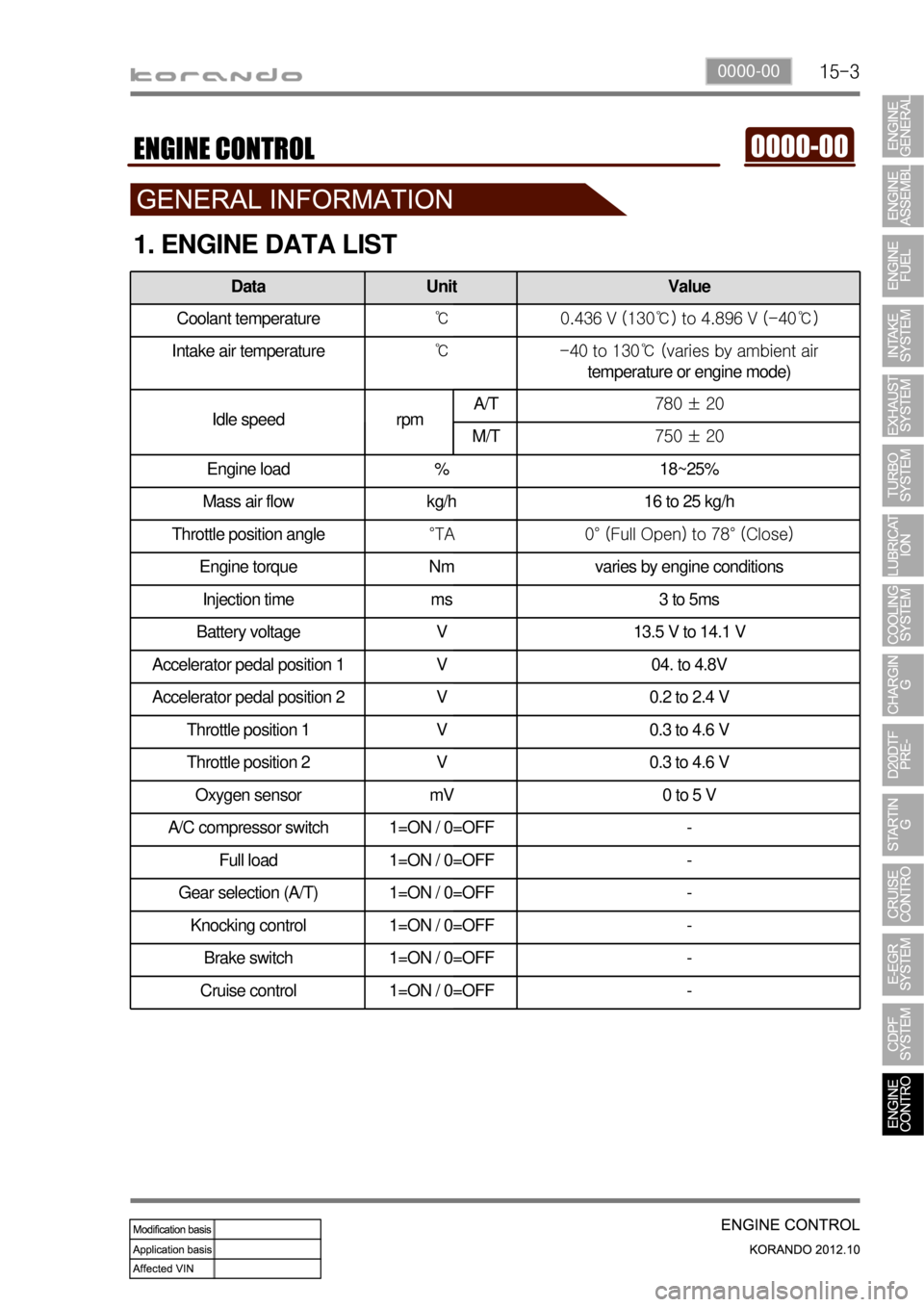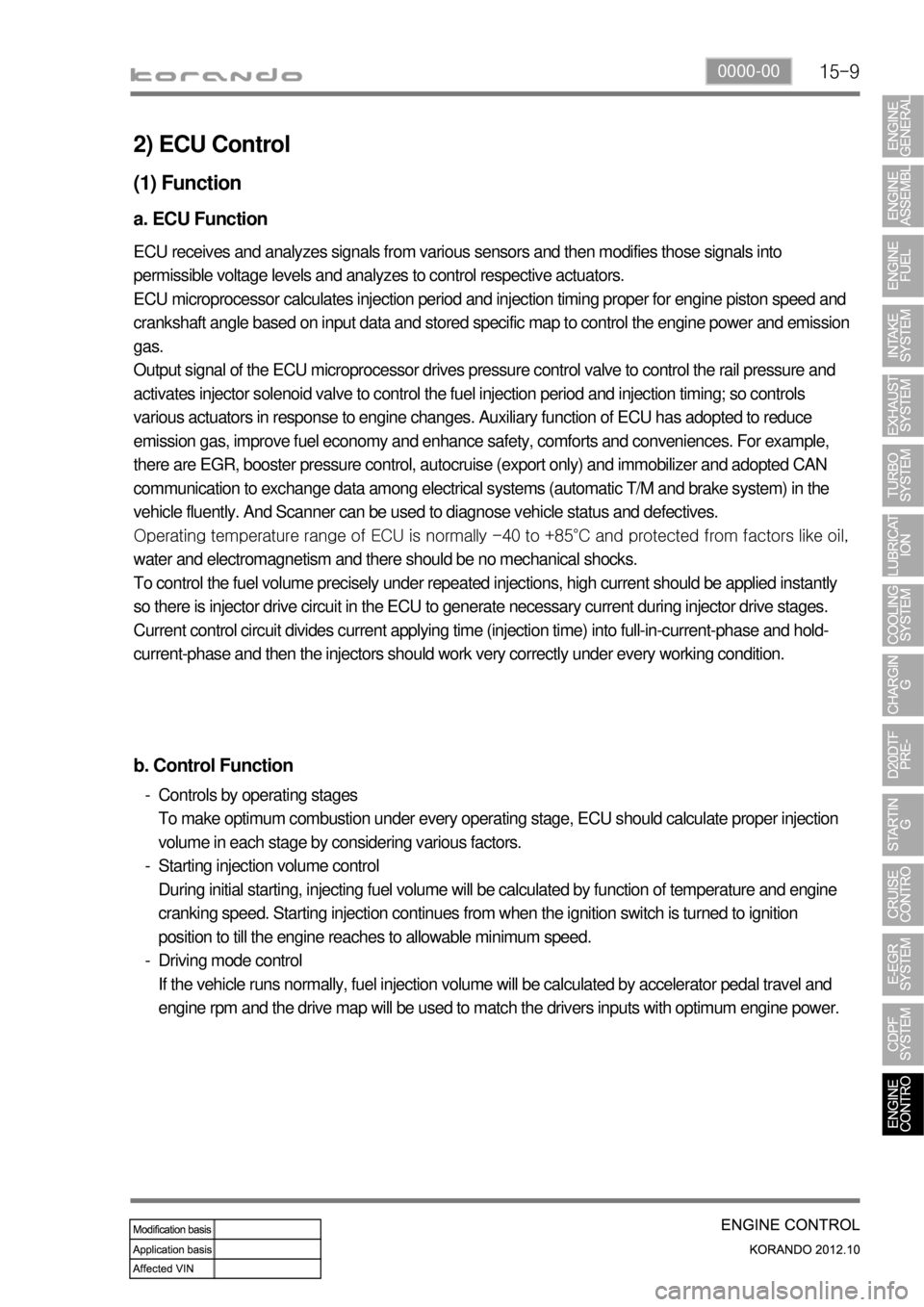cruise control SSANGYONG KORANDO 2012 User Guide
[x] Cancel search | Manufacturer: SSANGYONG, Model Year: 2012, Model line: KORANDO, Model: SSANGYONG KORANDO 2012Pages: 1082, PDF Size: 96.1 MB
Page 279 of 1082

15-30000-00
1. ENGINE DATA LIST
Data Unit Value
Coolant temperature℃ 0.436 V (130℃) to 4.896 V (-40℃)
Intake air temperature℃ -40 to 130℃ (varies by ambient air
temperature or engine mode)
Idle speed rpmA/T780 ± 20
M/T750 ± 20
Engine load % 18~25%
Mass air flow kg/h 16 to 25 kg/h
Throttle position angle°TA 0° (Full Open) to 78° (Close)
Engine torque Nm varies by engine conditions
Injection time ms 3 to 5ms
Battery voltage V 13.5 V to 14.1 V
Accelerator pedal position 1 V 04. to 4.8V
Accelerator pedal position 2 V 0.2 to 2.4 V
Throttle position 1 V 0.3 to 4.6 V
Throttle position 2 V 0.3 to 4.6 V
Oxygen sensor mV 0 to 5 V
A/C compressor switch 1=ON / 0=OFF -
Full load 1=ON / 0=OFF -
Gear selection (A/T) 1=ON / 0=OFF -
Knocking control 1=ON / 0=OFF -
Brake switch 1=ON / 0=OFF -
Cruise control 1=ON / 0=OFF -
Page 285 of 1082

15-90000-00
2) ECU Control
(1) Function
a. ECU Function
ECU receives and analyzes signals from various sensors and then modifies those signals into
permissible voltage levels and analyzes to control respective actuators.
ECU microprocessor calculates injection period and injection timing proper for engine piston speed and
crankshaft angle based on input data and stored specific map to control the engine power and emission
gas.
Output signal of the ECU microprocessor drives pressure control valve to control the rail pressure and
activates injector solenoid valve to control the fuel injection period and injection timing; so controls
various actuators in response to engine changes. Auxiliary function of ECU has adopted to reduce
emission gas, improve fuel economy and enhance safety, comforts and conveniences. For example,
there are EGR, booster pressure control, autocruise (export only) and immobilizer and adopted CAN
communication to exchange data among electrical systems (automatic T/M and brake system) in the
vehicle fluently. And Scanner can be used to diagnose vehicle status and defectives.
<00760097008c00990088009b00900095008e0047009b008c00940097008c00990088009b009c0099008c0047009900880095008e008c00470096008d0047006c006a007c00470090009a0047009500960099009400880093009300a000470054005b005700
47009b009600470052005f005c00b6006a004700880095008b> protected from factors like oil,
water and electromagnetism and there should be no mechanical shocks.
To control the fuel volume precisely under repeated injections, high current should be applied instantly
so there is injector drive circuit in the ECU to generate necessary current during injector drive stages.
Current control circuit divides current applying time (injection time) into full-in-current-phase and hold-
current-phase and then the injectors should work very correctly under every working condition.
b. Control Function
Controls by operating stages
To make optimum combustion under every operating stage, ECU should calculate proper injection
volume in each stage by considering various factors.
Starting injection volume control
During initial starting, injecting fuel volume will be calculated by function of temperature and engine
cranking speed. Starting injection continues from when the ignition switch is turned to ignition
position to till the engine reaches to allowable minimum speed.
Driving mode control
If the vehicle runs normally, fuel injection volume will be calculated by accelerator pedal travel and
engine rpm and the drive map will be used to match the drivers inputs with optimum engine power. -
-
-
Page 336 of 1082

01-12
4. CODING AND SETUP
1) Engine Variant Coding
Description Coding
Vehicle speed input to ECUCAN
with ABS or ESP: CAN
WIRE
Fan3 Relays
3 Relays
PWM fan
Auto cruiseNO
with Auto cruise system: YES
YES
Engine level controlNO
without Engine level control system: NO
(Korando)
YES
G-sensorNO
with 2WD ABS and non-ABS: NO
with 4WD ABS and ESP: YES
YES
Smart keyNO
with Smart key: YES
YES
Page 457 of 1082

12-38530-00
1. OVERVIEW
1) System Description
The cruise control is an automatic speed control system that maintains a desired driving speed without
using the accelerator pedal.
The vehicle speed must be greater than 38 km/h to engage the cruise control. This feature is especially
useful for motorway driving.
The cruise control system is a supplementary system, which helps the driver to drive the vehicle at a
desired speed without using the accelerator pedal under the traffic condition where the vehicle-to-
vehicle distance meets the legal requirement.
Auto cruise operated ECO cruise operated
Page 458 of 1082

12-4
2) Traffic Conditions for Using Cruise Control
Use the cruise control system only when the traffic is not jammed, driving on motorways or highways
where there is no sudden change in the driving condition due to traffic lights, pedestrian, etc.
Improper use of the cruise control could be dangerous.
Do not use on winding roadsyy .
Do not use in heavy traffic.
Do not use on slippery, wet roads.
This could result in a loss of control, collision, and/or personal injuries. -
-
-
Page 459 of 1082

12-58530-00
2. CONFIGURATION
1) Circuit Diagram
The engine ECU detects the operating conditions of cruise control system, and monitors the braking
performance, vehicle speed, road conditions and ESP system operation. If the engine ECU determines
that there are not any problem to drive in cruise control mode, the vehicle can be operated by cruise
switch signals (decelerating, accelerating, cruising).
Page 461 of 1082

12-78530-00
3. OPERATION
1) Setting a Desired Speed
To operate the cruise control, accelerate to the desired speed, which must be more than 38 km/h (24
MPH) and less than 150 km/h (90 MPH). In the vehicle equipped with manual transaxle, the gear shift
lever should be in 3rd or higher gear position.
Diesel engine equipped vehicle: When the desired speed is reached, press CRUISE ON (3) switch of
cruise control lever.
Gasoline engine equipped vehicle: When the desired speed is reached, press CRUISE ON (3) switch
of cruise control lever. The system is ready to activate the cruise control function. To activate the cruise
control function, push up (1) the ACCEL switch of the cruise control lever or push down (2) the DECEL
switch.
Now, the vehicle is cruised by this system with the set speed.
And you can set to other vehicle speeds again with above steps after an accelerator pedal intervention
during the cruise control running. 1.
2.
3.
4.
Never use the cruise control system until you get used to it.
Improper use or not fully aware of this function could result in collision and/or personal injuries.
Page 462 of 1082

12-8
2) Accelerating with the Cruise Control System
(1) While the cruise control system is running
Push up the ACCEL switch of the cruise control lever and hold it until the desired speed is reached
without an accelerator pedal intervention.
When the desired speed is reached, release the lever. 1.
2.
(2) When the cruise control system is not running
To increase the speed with the cruise control system while the system is not running, follow the
procedures below.
Accelerate using the accelerator pedal over 38 km/h.
Push up the ACCEL switch of the cruise control lever and hold it. And then release the accelerator
pedal slowly.
When the desired speed is reached, release the lever. 1.
2.
3.
(3) Tap-up while the cruise control system is running
To increase the vehicle speed in stages while the cruise control system is running, follow the procedures
below.
Push up the ACCEL switch of the cruise control lever less than 0.5 second per one switching while the
cruise control system is running. This is a tap-up switching. When you operate a tap-up switching, the
vehicle is accelerated for 1 km/h over the previous set speed.
If you want to accelerate for 10 km/h, operate the tap-up switching ten times without accelerating with
the cruise control system. 1.
2.
Page 463 of 1082

12-98530-00
3) Decelerating with the Cruise Control System
(1) While the cruise control system is running
Push down the DECEL switch of the cruise control lever and hold it until the desired speed is reached
without a brake pedal intervention. But the cruise control system cannot maintain the cruise function at
less than 38 km/h.
When the desired speed is reached, release the lever. 1.
2.
(2) When the cruise control system is not running
To decrease the vehicle speed with the cruise control system when the system is not running, follow the
procedures below.
Push down the cruise control switch lever to DECEL side and hold it until the desired speed is
reached while the vehicle speed is over 40 km/h.
And then release the accelerator pedal slowly.
When the desired speed is reached, release the lever. But the cruise control system cannot maintain
the cruise function at less than 38 km/h. 1.
2.
3.
(3) Tap-down while the cruise control system is running
To decrease the vehicle speed in stages while the cruise control system is running, follow the
procedures below.
Push down the DECEL switch of the cruise control lever less than 0.5 second per one switching while
the cruise control system is running. This is a tap-down switching. When you operate a tap-down
switching, the vehicle is decelerated for 1 km/h below the previous set speed.
If you want to decelerate for 10 km/h, operate the tap-down switching ten times without the brake
pedal intervention. 1.
2.
Page 464 of 1082

12-10
4) Recovery of Set Speed (RESUME)
Even if the cruise control is cancelled, the previous set cruise speed can be recovered by pulling up the
cruise control lever when the current vehicle speed is over 38 km/h without an acceleration intervention.
But if you turn off the ignition switch, the memorized set speed is cleared and you cannot recover the
previous set speed.
But the driver should know the previous set speed to react to the changed vehicle speed properly. If
the vehicle speed increases abruptly, depress the brake pedal to adjust the vehicle speed properly.